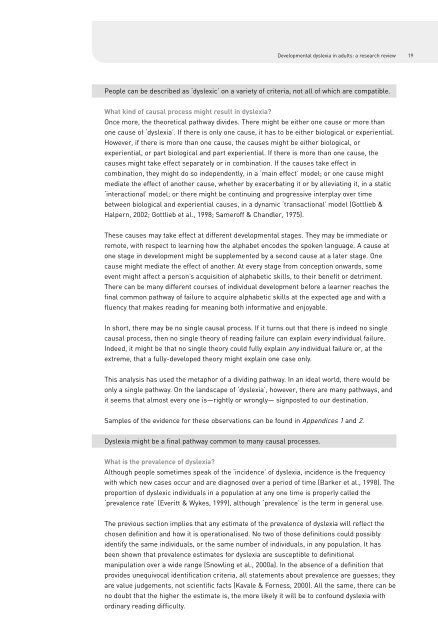01 NRDC Dyslexia 1-88 update - Texthelp
01 NRDC Dyslexia 1-88 update - Texthelp
01 NRDC Dyslexia 1-88 update - Texthelp
You also want an ePaper? Increase the reach of your titles
YUMPU automatically turns print PDFs into web optimized ePapers that Google loves.
Developmental dyslexia in adults: a research review 19<br />
People can be described as ‘dyslexic’ on a variety of criteria, not all of which are compatible.<br />
What kind of causal process might result in dyslexia?<br />
Once more, the theoretical pathway divides. There might be either one cause or more than<br />
one cause of ‘dyslexia’. If there is only one cause, it has to be either biological or experiential.<br />
However, if there is more than one cause, the causes might be either biological, or<br />
experiential, or part biological and part experiential. If there is more than one cause, the<br />
causes might take effect separately or in combination. If the causes take effect in<br />
combination, they might do so independently, in a ‘main effect’ model; or one cause might<br />
mediate the effect of another cause, whether by exacerbating it or by alleviating it, in a static<br />
‘interactional’ model; or there might be continuing and progressive interplay over time<br />
between biological and experiential causes, in a dynamic ‘transactional’ model (Gottlieb &<br />
Halpern, 2002; Gottlieb et al., 1998; Sameroff & Chandler, 1975).<br />
These causes may take effect at different developmental stages. They may be immediate or<br />
remote, with respect to learning how the alphabet encodes the spoken language. A cause at<br />
one stage in development might be supplemented by a second cause at a later stage. One<br />
cause might mediate the effect of another. At every stage from conception onwards, some<br />
event might affect a person’s acquisition of alphabetic skills, to their benefit or detriment.<br />
There can be many different courses of individual development before a learner reaches the<br />
final common pathway of failure to acquire alphabetic skills at the expected age and with a<br />
fluency that makes reading for meaning both informative and enjoyable.<br />
In short, there may be no single causal process. If it turns out that there is indeed no single<br />
causal process, then no single theory of reading failure can explain every individual failure.<br />
Indeed, it might be that no single theory could fully explain any individual failure or, at the<br />
extreme, that a fully-developed theory might explain one case only.<br />
This analysis has used the metaphor of a dividing pathway. In an ideal world, there would be<br />
only a single pathway. On the landscape of ‘dyslexia’, however, there are many pathways, and<br />
it seems that almost every one is—rightly or wrongly— signposted to our destination.<br />
Samples of the evidence for these observations can be found in Appendices 1 and 2.<br />
<strong>Dyslexia</strong> might be a final pathway common to many causal processes.<br />
What is the prevalence of dyslexia?<br />
Although people sometimes speak of the ‘incidence’ of dyslexia, incidence is the frequency<br />
with which new cases occur and are diagnosed over a period of time (Barker et al., 1998). The<br />
proportion of dyslexic individuals in a population at any one time is properly called the<br />
‘prevalence rate’ (Everitt & Wykes, 1999), although ‘prevalence’ is the term in general use.<br />
The previous section implies that any estimate of the prevalence of dyslexia will reflect the<br />
chosen definition and how it is operationalised. No two of those definitions could possibly<br />
identify the same individuals, or the same number of individuals, in any population. It has<br />
been shown that prevalence estimates for dyslexia are susceptible to definitional<br />
manipulation over a wide range (Snowling et al., 2000a). In the absence of a definition that<br />
provides unequivocal identification criteria, all statements about prevalence are guesses; they<br />
are value judgements, not scientific facts (Kavale & Forness, 2000). All the same, there can be<br />
no doubt that the higher the estimate is, the more likely it will be to confound dyslexia with<br />
ordinary reading difficulty.
















